Haben Sie sich von Ihrer WordPress-Website ausgesperrt?
Manchmal sperren Hacker Sie von Ihrer eigenen Website aus, indem sie Ihr Administratorkonto aus der Datenbank löschen.
In diesem Artikel zeigen wir Ihnen, wie Sie der WordPress-Datenbank über MySQL einen Admin-Benutzer hinzufügen können, damit Sie Ihren Zugang zurückbekommen.
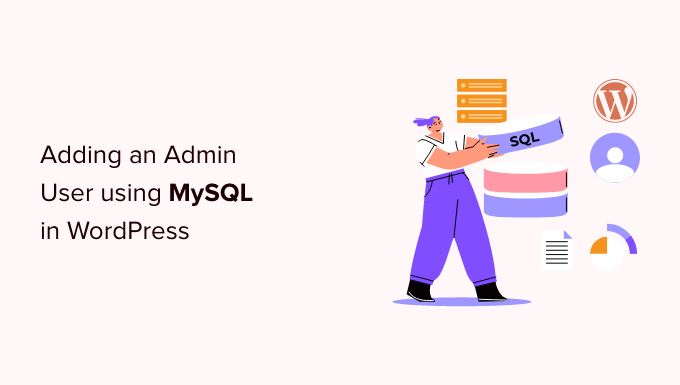
Warum einen Admin-Benutzer über MySQL zur WordPress-Datenbank hinzufügen?
Wir sind einmal auf ein Problem gestoßen, bei dem die Website eines Benutzers gehackt wurde und sein Administratorkonto aus der Datenbank gelöscht wurde. Dadurch wurde er von seiner WordPress-Website ausgesperrt.
Wir konnten ihnen helfen, Zugang zu ihrer Website zu erhalten, indem wir einen neuen Administrator-Benutzer direkt auf der WordPress-Website anlegten. Dazu verwendeten wir phpMyAdmin, ein webbasiertes Tool, mit dem Sie MySQL-Datenbanken über Ihren Webbrowser verwalten können.
Wenn Sie sich aufgrund von Hackern oder weil Sie Ihr Passwort vergessen haben, aus Ihrem WordPress-Administrationsbereich ausgesperrt haben, können Sie dies ebenfalls tun.
Sie sollten jedoch immer eine Sicherungskopie Ihrer Datenbank erstellen, bevor Sie irgendwelche MySQL-Bearbeitungen vornehmen. Sobald Sie sich wieder in Ihre Website einloggen können, sollten Sie unseren Leitfaden für Anfänger befolgen, um Ihre gehackte WordPress-Website zu reparieren.
Schauen wir uns also an, wie man einen Admin-Benutzer über MySQL zur WordPress-Datenbank hinzufügt.
Hinzufügen eines Admin-Benutzers zur WordPress-Datenbank mit phpMyAdmin
phpMyAdmin ist bei den meisten führenden WordPress-Hosting-Unternehmen vorinstalliert. Sie finden es im cPanel-Dashboard Ihres Hosting-Kontos im Bereich Datenbanken.
Hier ist ein Screenshot aus dem Bluehost-Kontrollzentrum:
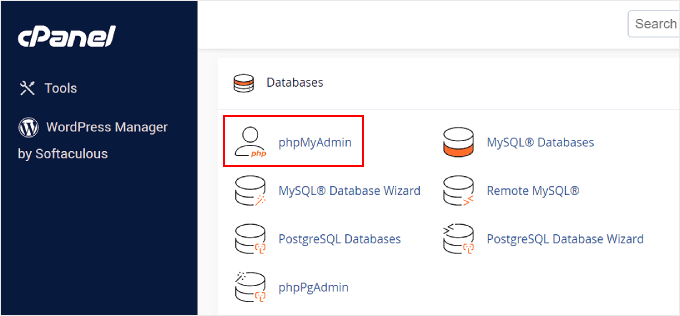
Wenn Sie auf das Symbol klicken, öffnet sich die phpMyAdmin-Oberfläche. Sie müssen Ihre WordPress-Datenbank in der linken Spalte auswählen.
Danach zeigt phpMyAdmin alle Tabellen in Ihrer WordPress-Datenbank an. Sie werden Änderungen an den Tabellen wp_users und wp_usermeta vornehmen.
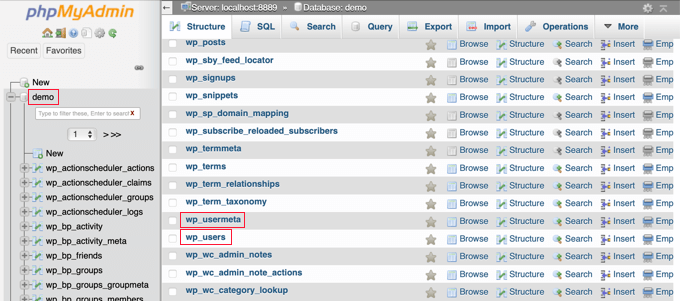
Hinzufügen eines Benutzers zur Tabelle wp_users
Zunächst müssen Sie die Tabelle wp_users finden und anklicken. Daraufhin werden die derzeit in der Tabelle aufgeführten Benutzer angezeigt.
Im Screenshot unten sehen Sie, dass es zwei Benutzer-IDs in der Tabelle unserer Demo-Website gibt, 1 und 2. Wenn wir einen neuen Benutzer für unsere Demo-Website anlegen, muss diese ID eindeutig sein, also geben wir die Nummer 3 ein.
Klicken Sie auf die Registerkarte „Einfügen“ am oberen Rand des Bildschirms, damit Sie die Informationen für einen neuen Verwaltungsbenutzer eingeben können.
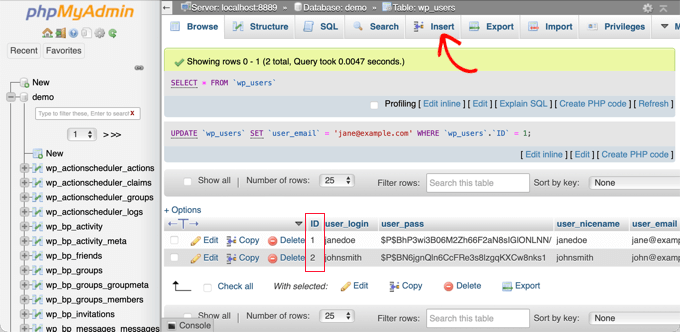
Fügen Sie die folgenden Informationen in die Felder des Formulars „Einfügen“ ein:
ID: Wählen Sie eine eindeutige Nummer (in unserem Beispiel verwenden wir 3)user_login: der Benutzername, der beim Einloggen verwendet wirduser_pass: Fügen Sie ein Passwort hinzu und stellen Sie sicher, dass Sie MD5 im Funktionsmenü auswählen (siehe Screenshot unten)user_nicename: der vollständige Name oder Spitzname des Benutzersuser_email: die E-Mail-Adresse des Benutzersuser_url: Ihre Website-Adresseuser_registered: Wählen Sie das Datum und die Uhrzeit der Registrierung des Benutzers über den Kalender aus.user_activation_key: leer lassenuser_status: setzen Sie diesen Wert auf 0display_name: der vollständige Name des Benutzers oder sein Anzeigename
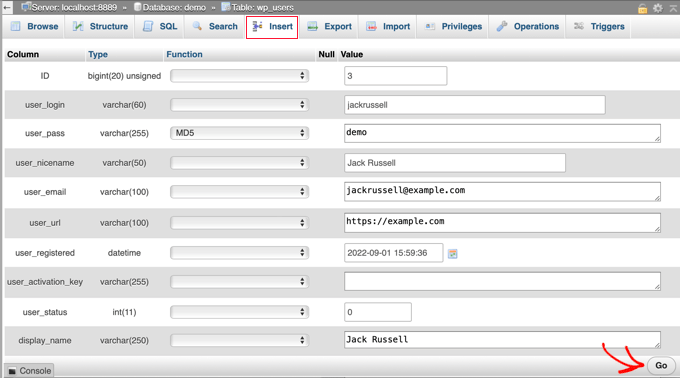
Wenn Sie fertig sind, klicken Sie auf die Schaltfläche „Go“, um den neuen Benutzer zu speichern.
Hinzufügen eines Benutzers zur wp_usermeta-Tabelle
Jetzt müssen Sie die Tabelle wp_usermeta finden und anklicken. Danach sollten Sie auf die Registerkarte „Einfügen“ klicken, wie Sie es im vorherigen Schritt getan haben.
Als Nächstes müssen Sie die folgenden Informationen in das Formular „Einfügen“ eingeben:
unmeta_id: leer lassen (sie wird automatisch generiert)user_id: die Benutzer-ID, die Sie im vorherigen Schritt verwendet habenmeta_key: dies solltewp_capabilitiesseinmeta_value: insert this:a:1:{s:13: "administrator";s:1: "1";}
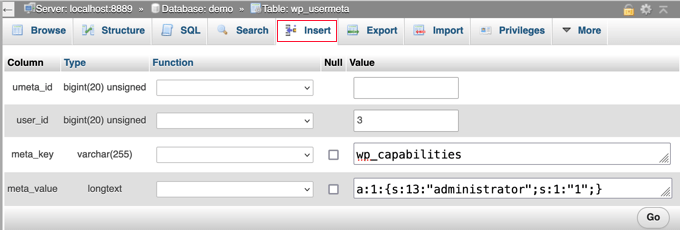
Wenn Sie dann nach unten scrollen, sollten Sie Felder für eine zweite Zeile finden. Sie müssen die folgenden Informationen hinzufügen:
unmeta_id: leer lassen (sie wird automatisch generiert)user_id: die Benutzer-ID, die Sie in den vorherigen Schritten verwendet habenmeta_key: Sie müssenwp_user_leveleingebenmeta_wert: 10

Wenn Sie alle Informationen in die Felder eingegeben haben, müssen Sie auf die Schaltfläche „Go“ klicken. Herzlichen Glückwunsch, Sie haben einen neuen Administrator-Benutzernamen erstellt!
Jetzt sollten Sie in der Lage sein, sich mit dem Benutzernamen und dem Passwort, die Sie für diesen Benutzer angegeben haben, in Ihrem WordPress-Administrationsbereich anzumelden.
Sobald Sie sich angemeldet haben, müssen Sie zu Benutzer “ Alle Benutzer navigieren und dann auf den gerade erstellten Benutzernamen klicken.
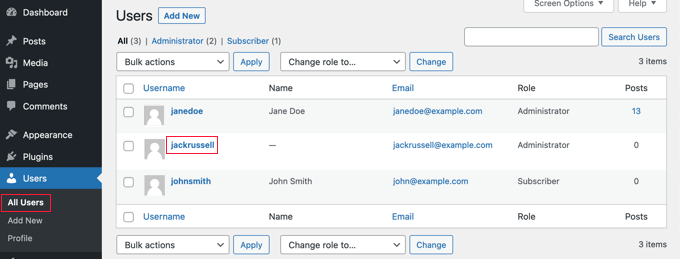
Blättern Sie nun, ohne etwas zu ändern, zum Ende der Seite und klicken Sie auf die Schaltfläche „Speichern“.
Dadurch kann WordPress den soeben erstellten Benutzer bereinigen und einige zusätzliche Informationen hinzufügen, die erforderlich sind.
Hinzufügen eines Admin-Benutzers zur WordPress-Datenbank mithilfe einer SQL-Abfrage
Wenn Sie ein Entwickler sind, können Sie den Prozess mit Code beschleunigen.
Legen Sie diese SQL-Abfrage einfach in Ihrer Datenbank ab:
INSERT INTO `databasename`.`wp_users` (`ID`, `user_login`, `user_pass`, `user_nicename`, `user_email`, `user_url`, `user_registered`, `user_activation_key`, `user_status`, `display_name`) VALUES ('3', 'demo', MD5('demo'), 'Your Name', 'test@example.com', 'http://www.example.com/', '2022-09-01 00:00:00', '', '0', 'Your Name');
INSERT INTO `databasename`.`wp_usermeta` (`umeta_id`, `user_id`, `meta_key`, `meta_value`) VALUES (NULL, '3', 'wp_capabilities', 'a:1:{s:13:"administrator";s:1:"1";}');
INSERT INTO `databasename`.`wp_usermeta` (`umeta_id`, `user_id`, `meta_key`, `meta_value`) VALUES (NULL, '3', 'wp_user_level', '10');
Stellen Sie sicher, dass Sie „databasename“ in die Datenbank ändern, mit der Sie arbeiten.
Vergessen Sie auch nicht, die anderen Werte so zu ändern, wie Sie es für den neuen Benutzer wünschen, wie wir es in der ersten Methode erklärt haben.
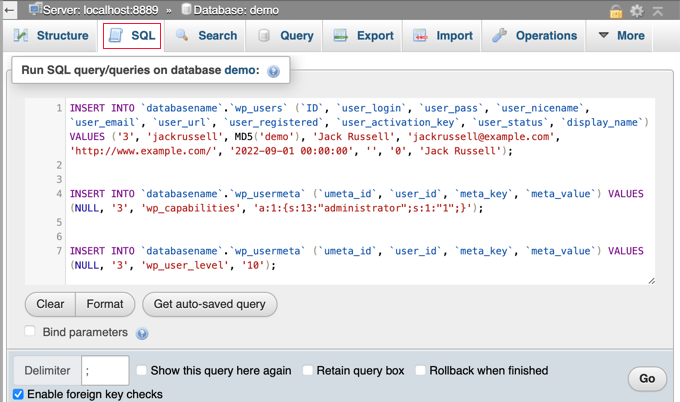
Expertenratschläge, was zu tun ist, wenn man aus dem WordPress-Admin ausgesperrt ist
Da Sie nun wissen, wie Sie einen Admin-Benutzer über MySQL hinzufügen können, möchten Sie vielleicht einige Artikel darüber lesen, wie Sie Ihre Website reparieren können, wenn Sie aus dem WordPress-Administrationsbereich ausgesperrt sind.
- Was ist zu tun, wenn Sie aus dem WordPress-Administrationsbereich (wp-admin) ausgesperrt sind?
- Wie man den WordPress-Wiederherstellungsmodus verwendet
- Wie man ein WordPress-Passwort von phpMyAdmin aus zurücksetzt
- Wie man die Beschränkung der Login-Versuche in WordPress aufhebt
- Deaktivieren aller Plugins, wenn kein Zugriff auf WP-Admin möglich ist
- Wie man den WordPress White Screen of Death behebt (Schritt für Schritt)
- Wie man den kritischen Fehler in WordPress behebt (Schritt für Schritt)
- Wie behebt man das Problem der Aktualisierung und Weiterleitung der WordPress-Login-Seite?
- So beheben Sie den Fehler beim Herstellen einer Datenbankverbindung in WordPress
- Wie man den Fehler „Diese Website kann nicht erreicht werden“ in WordPress leicht behebt
Wir hoffen, dass dieses Tutorial Ihnen geholfen hat, zu lernen, wie man einen Admin-Benutzer zur WordPress-Datenbank über MySQL hinzufügt. Vielleicht interessieren Sie sich auch für unseren ultimativen WordPress-Sicherheitsleitfaden oder unsere Liste der häufigsten WordPress-Fehler und deren Behebung.
Wenn Ihnen dieser Artikel gefallen hat, dann abonnieren Sie bitte unseren YouTube-Kanal für WordPress-Videotutorials. Sie können uns auch auf Twitter und Facebook finden.





Syed Balkhi says
Hey WPBeginner readers,
Did you know you can win exciting prizes by commenting on WPBeginner?
Every month, our top blog commenters will win HUGE rewards, including premium WordPress plugin licenses and cash prizes.
You can get more details about the contest from here.
Start sharing your thoughts below to stand a chance to win!
Kris says
I wanted to delete all spam emails registered in my site. I went to myPhpAdmin and deleted all including mine (without knowing). I searched the web ‚til I landed at this page.
Good Job! It worked!
Donato says
Not sure where I went wrong but I get this when trying to login: You do not have sufficient permissions to access this page.
redhad says
Hello Donato,
Change the „wp_“ prefix of „wp_capabilities“ and „wp_user_level“ to whatever prefix you have set. Example, if you changed your wordpress prefix as „mysite_“ then the insert command should be:
INSERT INTO `databasename`.`mysite_usermeta` (`umeta_id`, `user_id`, `meta_key`, `meta_value`) VALUES (NULL, ‚4‘, ‚mysite_capabilities‘, ‚a:1:{s:13:“administrator“;s:1:“1″;}‘);
INSERT INTO `databasename`.`mysite_usermeta` (`umeta_id`, `user_id`, `meta_key`, `meta_value`) VALUES (NULL, ‚4‘, ‚mysite_user_level‘, ’10‘);
Chetan Dhiman says
Thanks a lot! It helped me a lot !!!
nishad says
Really great help, I solved my admin access error. Thanks.
Rupert says
Great post – quick not – wp_capabilities and wp_user_level need to match the prefix in the DB…
Lou Storiale says
Thank you for this… very easy to follow! I never would have intuitively thought I would have to add two record in the same table. Thank you again.
WordPress add admin record… I never thought I would have gotten this done in 5 minutes.
Allison Wong says
Thank you! I love when things work! I went through the instructions as stated above and everything worked out. Just a tip – if you changed the prefix of your database tables from wp_ to something else, make sure to replace it in the code above.
Houston says
Thanks, Dasha! You’re a life saver! Was stumped until I saw I needed to also change the DB prefix for ‚wp_capabilities‘ and ‚wp_user_level‘!
Casey Friday says
This has helped me multiple times, when other developers send me sites to work on without making me an admin account. Thanks!
Ruben says
Hi, thanks for the clear tips. It nearly worked – but had to change a:1:{s:13:”administrator”;s:1:”1″;} with a:1:{s:13:“administrator“;s:1:“1″;} – looks the same, just replace all the quotes (which are curly quotes) with normal quotes. Or don’t be lazy andwrite it instead of cut and paste. Otherwise the new user I created didn’t have admin access. Phew that was difficult,
Reena says
omg.. what a life saver. Just a tip you need to update the wp_capabilities meta_key value to ‚a:1:{s:13:“administrator“;b:1;}‘. And for some reason it still didn’t allow me to login. So then I just typed in the new username I created and clicked on forgot password. WP sent me a password reset link and all was well.
captain says
how can i add multiple images into wp_usermeta.
Jamie says
I was able to gain access with the original process but now my dashboard is blank. Any ideas on what I need to do? thanks
Nathan Swartz says
As of today you also have to add another entry (and probably not the wp_user_level, not sure about that though), wp_capabilities with a value of a:1:{s:13:“administrator“;b:1;}
Erik says
You’ve got a small bug. you’ll need to update the wp_capabilities meta_key value to ‚a:1:{s:13:“administrator“;b:1;}‘ for this to work correctly, otherwise great article
Gabriel Luethje says
Yep, I got locked out until I figured this one out.
Daniel Duckworth says
Thanks Erik!
mitzi says
Thank you! To both the original author and you for the fix. Saving my bacon right now…
Keenan Flogerzi says
Agreed.
Might be a good idea to post those types of things using code formatting, instead of just regular text.
Dasha says
Thank you for the tutorial – very useful. However, it would be handy if there was a note that ‚wp_capabilities‘ and ‚wp_user_level‘ use default database prefix, i.e. ‚wp_‘. If a site uses a custom DB prefix that it should be used in those strings instead.
Houston says
Thanks, Dasha! You saved me!
Juan says
After finding your sollution i tweaked it a bit you can actually do everything in 2 queries without having to remember the id you create.
Both queries have to be executed in the same action (so the same SQL input box).
INSERT INTO `wp_users` (`ID`, `user_login`, `user_pass`, `user_nicename`, `user_email`, `user_url`, `user_registered`, `user_activation_key`, `user_status`, `display_name`)
VALUES
(NULL , ‚username‘, MD5(‚password‘), ‚User Name‘, ‚email@domain.ext‘, “, NOW(), “, ‚0‘, ‚User Name‘);
INSERT INTO `wp_usermeta` (`umeta_id`, `user_id`, `meta_key`, `meta_value`)
VALUES
(NULL, LAST_INSERT_ID(), ‚wp_capabilities‘, ‚a:1:{s:13:“administrator“;s:1:“1″;}‘),
(NULL, LAST_INSERT_ID(), ‚wp_user_level‘, ’10‘);
Sara says
This worked perfectly! Thanks Juan!
codeshark says
This works perfectly and is so much easier than inserting everything manually. Juan, thank you and well done sir.
Jim says
I followed the instructions but keep getting an „invalid username“ error when trying to login.
I’ve created 3 different users but still continue getting this error.
AndreaCavallieri says
I have the same problem. How can we solve?
Clare says
So glad I found this. Worked like a dream once I got the correct brackets and the right code for the version of WP that was installed
ReeZh says
It works! running this tuts saving my time. Thanks a lot Mr. Syed.
aleo monts says
GREAT Thanks!
elad says
thanks mate, worked like a charm.
Robin Jennings says
Worked a treat. Nice and simple tutorial- much appreciated.
XYZ says
Thank you very much…it worked.
Abdul Aziz says
not working , i don’t no what mistake i have made…
it’s showing this error
„““ You do not have sufficient permissions to access this page. „“
Steve Della-Valentina says
It seems like the latest version of WordPress has tweaked their meta keys and values to:
dqf_capabilities -> a:1:{s:13:“administrator“;b:1;}
dqf_user_level -> 10
I saw the insufficient permissions prompt before noticing this, then changing the keys and values fixed it!
Alvise says
Hi tried but I always get the same warning : You don’t have permissions……
What can I do??
Thanks!
Andy says
it’s the quotes. Curly quotes are not the same in your DB. Paste that line into your DB, then delete the quotes you pasted in and type new ones.
mbd says
this is solution.. thanks
Ginette says
Was ok one day and then the next – lost my admin access. Thanks for this – saved me a heap of frustration. Plus I’ve learnt some sql to boot!
Cheers!
Joe Hana says
Thanks for this post. Just helped me to save some time. Works great.
Raspal says
Hello,
I had a blog hosted at web host A and moved to another webhost recently. I don’t have the account with web host A any longer but have the full backup of the WP blog on my computer. I restored the backup to this new webhost B and the database as well. The blog is accessible fine. But I’m not able to login to wp-admin using any of the three admin user logins I have in the database. I checked the database from phymyadmin and all the three users are there fine.
I also tried to change passwords of these users. I get the link to change the password, but when I try to login to wp-admin using the new password, even then I get the same WP login screen without any error shown.
I also tried the method you gave above, to create a new user. I did as per all the steps and also tried what the commenters have suggested, but still I’m not able to login.
I tried deleting all the tables for this blog and then again imported the database. Doing this and trying to logging in just gives a message that the database needs to be updated before I can login. So, clicking the yes, I again get the login screen and the above process repeats – getting the same WP login screen with no error.
Note that I’m using the WP Better Security plugin and even tried deleting the plugin using FTP, but the same thing, still.
Can you tell me what can be done in this situation and where am I going wrong? Please help.
Thank you.
Kind Regards,
Raspal
WPBeginner Support says
Please check your wp-config.php file make sure that it has your new database name, username, and host information. Delete .htaccess file from the root of your site. Rename plugins directory in your /wp-content/ folder. This will deactivate all your plugins. Lastly, in phpmyadmin go to wp_options table and look for homeurl and siteurl options make sure they are pointing to your domain name. Report back if none of these steps resolve your issue.
Admin
Raspal says
Thanks for the help. I re-checked everything you mentioned above and all those things were perfect. After 2 days of fiddling, it striked me that I hadn’t tried clearing Chrome’s cache and cookies, silly me! This simple thing solved the problems which wasted my two days‘ time. Sorry to have wasted your and others‘ time too who read this.
Anyway, everyone make sure to clear your cookies and cache every few days, Cookies and cache are responsible for really wierd problems. I don’t know about others but I like to keep my cookies for ages because they contain passwords to many (not-so-important but regular) sites I visit. And I take it for granted that cookies aren’t the culprit. Turned out to be wrong! Now, I have sent myself a reminder which tells me to clear the cookies and cache from all my browsers.
Thanks again for the help. At least the options you mentioned, I will surely remember if something like this happens again. And I also learnt how to use phpmyadmin to create and even edit WP users. And in the process, I saw a table called lockdowns. This is created by WP Better Security plugin and I now know that I can clear this table or change the values if I am locked out of the login screen for bad logins. Thanks Syed and editorial staff!
And in the process, I saw a table called lockdowns. This is created by WP Better Security plugin and I now know that I can clear this table or change the values if I am locked out of the login screen for bad logins. Thanks Syed and editorial staff!
Kind Regards,
Raspal
Colin Steinmann says
There is a very slight (but critical) typo in your tutorial:
a:1:{s:13:”administrator”;s:1:”1″;} <—-this is not correct by a single character
a:1:{s:13:"administrator";s:1:"1";} <—-this is correct, the final ″ should be a "
The two characters look almost exactly the same, but they are slightly different.
Julio says
This was very helpful. I was getting a „not enough access“ error. After this tweak, we’re all set.
Alex says
Thank you very much! That was the solution to make this tutorial work nice!!!
Tiago says
Nice, it works!
Just chanced the a:1:{s:13:”administrator”;b:1;} for the equivalent already listed in wp-capabilities and worked fine to me.
Lane says
I’ve followed all these steps, but it doesn’t appear my new user I created has been given admin role. When I log in to WordPress with the username and password I just created all I am able to see is the „Profiles“ tab of the dashboard. Obviously I am missing a step along the way, but I have created two new users following this and it’s happened both time. Does anyone know what I may be doing wrong?
Haseeb Ahmad Ayazi says
Can I use this Same Procedure for Multisite…????
Haseeb Ahmad Ayazi says
Didn“t work… I am unable to login in my multisite network. Please Help me
Hope Corizzo says
Wow. Many thanks! php always freaks me out, and I was able to follow this very well. I appreciate it.
Editorial Staff says
Glad it worked out
Admin
alan says
This don’t work tried loads of times and still cannot log in.
(unmeta_id – leave this blank (it will be auto-generated)
user_id – this will be the id of the user you created in the previous step. Remember we picked 4.
meta_key – this should be wp_capabilities
meta_value – insert this: a:1:{s:13:”administrator”;s:1:”1″;}
Insert another row with the following information:
unmeta_id – leave this blank (it will be auto-generated)
user_id – this will be the id of the user you created in the previous step. Remember we picked 4.
meta_key – this should be wp_user_level
meta_value – 10 )
this part is where i think i am going wrong , i can see user created but it does not log in
Kristian Lander says
a useful guide, to an issue i found of a hacker who deleted the admin alos. however upon inserting a new admin. i get the error message of INSERT command denied to user „database name“ @hosting for table „wp_users“
any ideas?
Anthony says
Thanks, this works a treat. I just copied your SQL and ping! I used MySQL Bench not phpmyadmin.
Oscar Rottink says
Maybe a weird question, but I followed the steps and can’t login. Also watched for the brackets etc.
So I tried ‚forgot password‘ and entered my e-mail which is also in the wp_users table. But it says no user is registered with that e-mail.
Anyone a clue what I missed?
Oscar Rottink says
OMG sorry. My fault. I didn’t changed the base URL in the database so my local copy (and login) were pointing at the original site. Feeling stupid.
Adam says
If you copied the code a:1:{s:13:“administrator“;b:1;} from this blog, it is possible that you got curly quotes instead of regular quotes, which will not work.
Gleb says
Man, thanks! Easiest things get easily forgotten You saved me digging through the database for answers..
You saved me digging through the database for answers..
Jasper Frumau says
Thanks for that tip. Now it does work fine and dandy.
Albert A. Ninyeh says
There was a problem with the wp_capabilities valve you gave and the problem was with the quotes. the correct one is: wp_capabilities should be a:1:{s:13:“administrator“;s:1:“1″;}
Anyone who wants to solve this problem should copy it exactly as it appears.
George says
I by accident logged in before adding the „usermeta“ info. It of course read „You do not have sufficient permissions to access this page.“ Even after I added the usermeta info I get the same thing.
Any thoughts on this?
Editorial Staff says
Check to see if the prefix is the same as your main database prefix. We are assuming that the user is using the default wp_ prefix. If your database prefix is something else, then it wouldn’t work.
Admin
Nat says
I’ve tried everything and I still keep getting „You do not have sufficient permissions to access this page.“ Any ideas on why this might be happening? Thanks.
David Abramson says
I was getting the same error message and I think the problem comes from the check box in the second row that says „ignore“. It was checked by default for me and I got it to work once I unchecked that box.
JasonC says
Thank you so much this finally allowed me to get into my site. I tried every possible option to reset the admin password but nothing would work. I created the new account and logged in as administrator and was then able to export my work. Thanks again!
Vic Dinovici says
Hi, great article, thanks! Have a different issue though, my entire wp_users table got deleted and I don’t know how to create a wp_users table using phpMyAdmin. Can anyone help? Thanks!
Editorial Staff says
Did you try repairing your database using the WordPress repair tool? Maybe that adds it back. Otherwise, you are better off reinstalling WordPress. For future, keep good backups.
Admin
Vic Dinovici says
using the repairing DB WordPress tool won’t create the wp_users table. What I did is deleting the unused tables from the old one, lowering it’s size and uploading it again. It worked. Thanks.
sibz says
After attempting to log in it sais..
You do not have sufficient permissions to access this page
why did this happen?
Thanks
Editorial Staff says
This happens if your user permissions level aren’t correct. Can you make sure that the permission level is the same as the other admin user in your phpMyAdmin
Admin
Sibz says
I have applied same user level as 10.
But still does not work
Can my developer have any access to my
Cpanel if she doesnt have my ftp or cpanel
Log in details?
I see in phpmyadmin she is listed as admin.
Its all so confusing especially when im new to all
Of this!
Chris Cox says
Guide is out of date. The correct string for wp_capabilities is now:
a:1:{s:13:“administrator“;s:1:“1″;}
Editorial Staff says
Updated the guide.
Aman Yadav says
Thanks it worked perfectly for me
John says
Thank you. You just saved my arse!!
nimbleswitch says
I echo Ravi’s suggestion to copy the meta value from another admin. In my case „wp_capabilities“ was actually databaseName-„_capabilities“ and my admin level looked like this: a:2:{s:13:“administrator“;s:1:“1″;s:17:“gform_full_access“;s:1:“1″;}
Thanks for the great article. Saved my day.
Iryna says
Copying of the wp_capabiblities-value from another admin helped me to. In my case the value was a:1:{s:13:“administrator“;s:1:“1″;}. Until this change I had recieved: “You do not have sufficient permissions to access this page.”
ravidreams says
Thanks for the useful article.
a:1:{s:13:”administrator”;b:1;} didn’t work for me. I had to copy the meta value from another admin user and then it worked.
michoscopic says
For those who encounter „You do not have sufficient permissions to access this page.“, replace „wp_capabilities“ with your full wordpress table name, e.g. if your usermeta tables are called wp_yourtableusermeta (as opposed to wp_usermeta in this tutorial), then you need to use wp_yourtablecapabilities instead. Same goes for wp_user_level, change it to wp_yourtableuser_level. Hope this helps.
MohitBumb says
You do not have sufficient permissions to access this page.
mr.minhkhang says
In my opinion tampering with MySQL should not be on wp’beginner‘, messing around with the database is simply not a beginner thing.
I don’t know when this was posted, but the time when WordPress used MD5 has long gone. This article should be updated to use wp_hash_password instead.
Tiago says
One day you need to begin to mess around with not so beginner things.. lols
annedreshfield says
Hi guys, Anne here, community manager intern at Livefyre. Welcome! Just wanted to drop in and say that everyone here loves this blog; it’s full to the brim with fantastic information. Can’t wait to read more!
blainesch says
I was pretty sure the password was md5 but also using a salt stored in the config file it creates.
Kosta Welissariou says
Hi,
I hope to get some help here. My blog was hacked with some base64 stuff. I can solve 99% of all the problems but I have 2 Admins in my wp Backend that need to be removed from mysql table before I can take other actions
Sorry, no clue how to track the adin in the table and remove them
WP latest
Access to the mysql database
tks
Kosta
Editorial Staff says
Look in the wp_users table. Delete the users that you don’t want.
Admin
phil says
If it was salted, just follow the steps, add a real email and have it send you a password reset. Boom. hope that helped.
hope that helped.